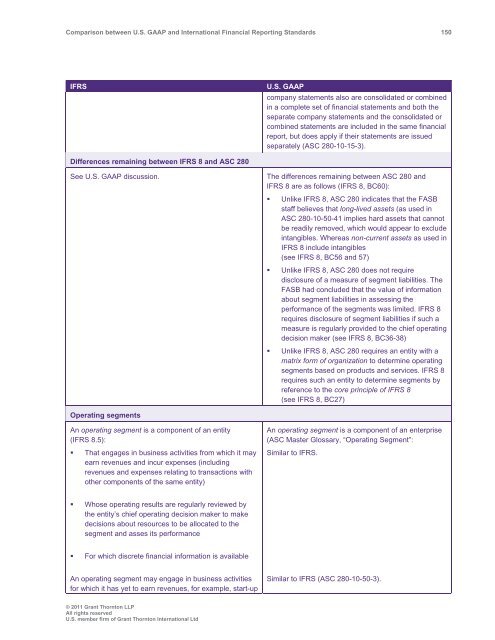Comparison between U.S. GAAP and International ... - Grant Thornton
Comparison between U.S. GAAP and International ... - Grant Thornton
Comparison between U.S. GAAP and International ... - Grant Thornton
Create successful ePaper yourself
Turn your PDF publications into a flip-book with our unique Google optimized e-Paper software.
<strong>Comparison</strong> <strong>between</strong> U.S. <strong>GAAP</strong> <strong>and</strong> <strong>International</strong> Financial Reporting St<strong>and</strong>ards 150<br />
IFRS<br />
U.S. <strong>GAAP</strong><br />
company statements also are consolidated or combined<br />
in a complete set of financial statements <strong>and</strong> both the<br />
separate company statements <strong>and</strong> the consolidated or<br />
combined statements are included in the same financial<br />
report, but does apply if their statements are issued<br />
separately (ASC 280-10-15-3).<br />
Differences remaining <strong>between</strong> IFRS 8 <strong>and</strong> ASC 280<br />
See U.S. <strong>GAAP</strong> discussion.<br />
The differences remaining <strong>between</strong> ASC 280 <strong>and</strong><br />
IFRS 8 are as follows (IFRS 8, BC60):<br />
• Unlike IFRS 8, ASC 280 indicates that the FASB<br />
staff believes that long-lived assets (as used in<br />
ASC 280-10-50-41 implies hard assets that cannot<br />
be readily removed, which would appear to exclude<br />
intangibles. Whereas non-current assets as used in<br />
IFRS 8 include intangibles<br />
(see IFRS 8, BC56 <strong>and</strong> 57)<br />
• Unlike IFRS 8, ASC 280 does not require<br />
disclosure of a measure of segment liabilities. The<br />
FASB had concluded that the value of information<br />
about segment liabilities in assessing the<br />
performance of the segments was limited. IFRS 8<br />
requires disclosure of segment liabilities if such a<br />
measure is regularly provided to the chief operating<br />
decision maker (see IFRS 8, BC36-38)<br />
• Unlike IFRS 8, ASC 280 requires an entity with a<br />
matrix form of organization to determine operating<br />
segments based on products <strong>and</strong> services. IFRS 8<br />
requires such an entity to determine segments by<br />
reference to the core principle of IFRS 8<br />
(see IFRS 8, BC27)<br />
Operating segments<br />
An operating segment is a component of an entity<br />
(IFRS 8.5):<br />
• That engages in business activities from which it may<br />
earn revenues <strong>and</strong> incur expenses (including<br />
revenues <strong>and</strong> expenses relating to transactions with<br />
other components of the same entity)<br />
An operating segment is a component of an enterprise<br />
(ASC Master Glossary, “Operating Segment”:<br />
Similar to IFRS.<br />
• Whose operating results are regularly reviewed by<br />
the entity’s chief operating decision maker to make<br />
decisions about resources to be allocated to the<br />
segment <strong>and</strong> asses its performance<br />
• For which discrete financial information is available<br />
An operating segment may engage in business activities<br />
for which it has yet to earn revenues, for example, start-up<br />
Similar to IFRS (ASC 280-10-50-3).<br />
© 2011 <strong>Grant</strong> <strong>Thornton</strong> LLP<br />
All rights reserved<br />
U.S. member firm of <strong>Grant</strong> <strong>Thornton</strong> <strong>International</strong> Ltd
















